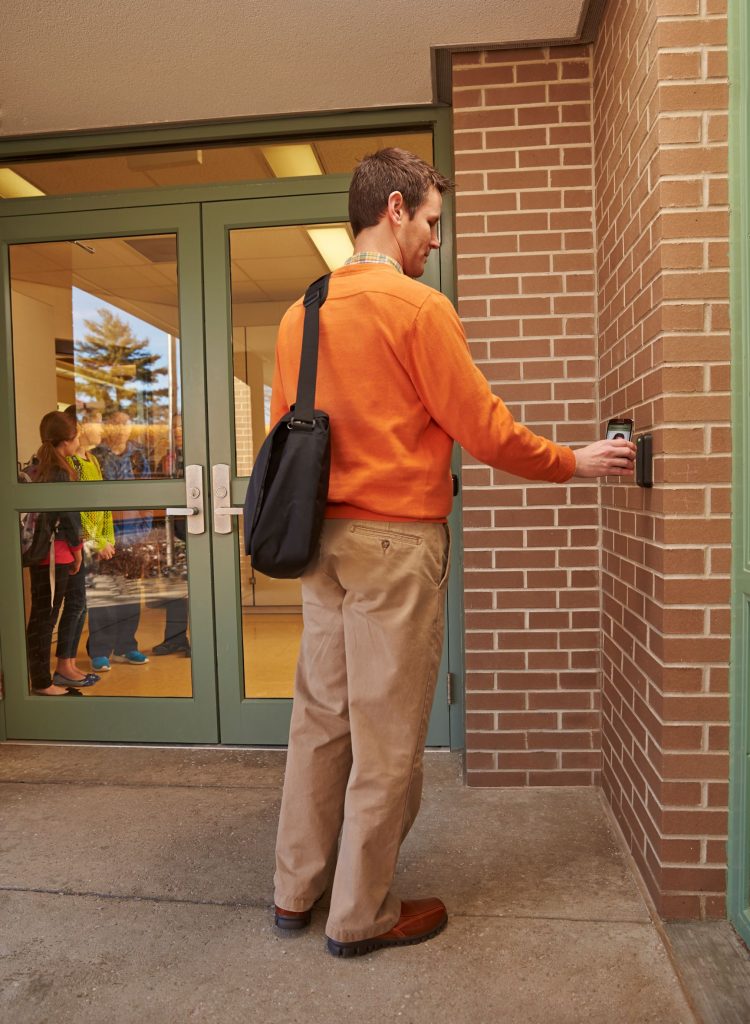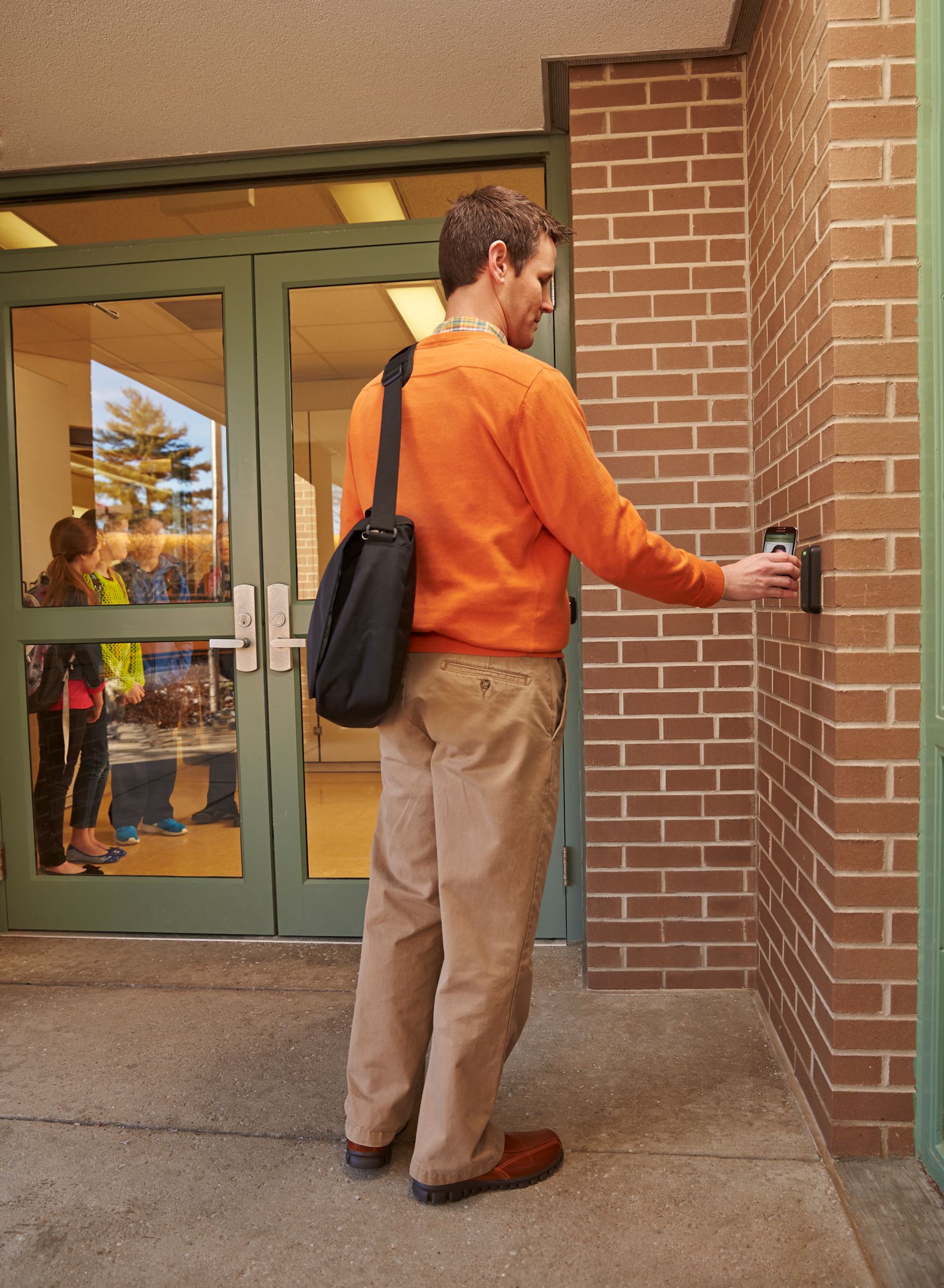
When a door with an access control reader on the exterior allows free egress at all times via the electromechanical hardware, the UL 294 listing is not required by the model codes.
Has this happened to you? You breathe a sigh of relief as the access control hardware on your project is up and running properly, just in time for the CofO (Certificate of Occupancy) inspection. Then the other shoe drops. You are asked to provide evidence that all of the electrified hardware on the job is listed to UL 294 – Standard for Access Control System Units.
References to the UL 294 listing have become more prevalent in the last few editions of the model codes, with one additional change made to NFPA 101-2021. As with many code changes affecting door hardware – especially electrified hardware – there have been questions about when this standard applies.
Not all electrified hardware is required by the model codes to carry the UL 294 listing. This standard is for access control systems, but the listing is only required by code for certain types of systems that incorporate electrified hardware – usually systems that affect egress. An automatic operator, for example, is not covered by the UL 294 standard even though it is electrified hardware. An access control door with electromechanical hardware that allows free egress at all times is not required by the model codes to have the UL 294 listing. On the other hand, a delayed egress lock would require the UL 294 listing if the project had to comply with the International Building Code (IBC) or NFPA 101 – Life Safety Code. So how do you know when the listing is required and when it is not?
As I wrote in a past article for Doors & Hardware, there are 4 references to UL 294 in the International Building Code IBC:
- Door hardware release of electrically locked egress doors (previous title: Electromagnetically locked egress doors) (2021: 1010.2.11; 2018: 1010.1.10; 2015: 1010.1.9.9; UL 294 not required by prior editions) – applies to electrified locking hardware (typically electromagnetic locks) that are released by a switch in the door-mounted hardware.
- Sensor release of electrically locked egress doors (previous title: Access controlled egress doors) (2021: 1010.2.12; 2018: 1010.1.9.9; 2015: 1010.1.9.8; 2012: 1008.1.9.8) – applies to electrified locking hardware (typically electromagnetic locks) that are released by a sensor to allow egress.
- Delayed egress locks (2021: 1010.2.13; 2018: 1010.1.9.8; 2015: 1010.1.9.7; UL 294 not required by prior editions) – applies to delayed egress locks that release within 15 seconds after actuation of the release timer (or 30 seconds when approved by the AHJ).
- Controlled egress doors in Groups I-1 and I-2 (2021: 1010.2.14; 2018: 1010.1.9.7; 2015: 1010.1.9.6; UL 294 not required by prior editions) – applies to the electrified locking of egress doors in certain types of units in a health care facility.
And there are currently 6 references in NFPA 101 – Life Safety Code (1 is new in 2021):
To determine whether the listing is required for a particular product, there are 2 questions to answer:
- Which code is the project required to comply with? If it’s the IBC, there are 4 possible applications where the listing is required; if it’s NFPA 101, there are 6 applications.
- Is the product used in one of the access-control systems listed above? If the hardware in question is not used in one of the applications covered by these sections, the model codes do not currently require the UL 294 listing for the components of that system.
Let’s try some examples using the 2021 editions of the IBC and NFPA 101:
- Panic hardware with electric latch retraction used on an exterior door, where a card reader retracts the latch for access and the panic hardware allows free egress – UL 294 is not needed because this application is not required to comply with any of the code sections listed above.
- An electromagnetic lock that is released by a sensor that detects an approaching occupant – UL 294 is required by the IBC (2021 Section 1010.2.12) and is also required by NFPA 101 2021 and 2018 editions (not prior editions), since UL 294 is referenced in Section 7.2.1.6.2 – Sensor release of electrical locking systems.
- An electromagnetic lock that is released by a switch in door-mounted hardware – UL 294 is required by both the IBC (2021 Section 1010.2.11) and NFPA 101 (2021 Section 7.2.1.6.3).
- A fail safe electromechanical lock that allows free egress to a stairwell and can be remotely unlocked on the stair side for stairwell reentry – UL 294 is not required by the IBC because the UL 294 listing is not required by the stairwell reentry section (2021 IBC section 1010.2.7). However, the 2021 edition of NFPA 101 added the UL 294 listing requirement to 2021 Section 7.2.1.5.7. The UL 294 listing is now required by NFPA 101 for stairwell reentry doors, but is not required by the IBC.
- Delayed egress panic hardware which delays egress for 15 seconds and allows immediate egress upon fire alarm – UL 294 is required by the IBC (2021 Section 1010.2.13) and since the 2018 edition has also been required by NFPA 101 (Section 7.2.1.6.1).
- Fail secure electromechanical lockset used to secure a room against access with free egress provided at all times by the interior lever handle – the UL 294 listing is not required because this application is not subject to the requirements of the code sections referenced above..
Any questions? If you want to check any other examples, just leave a comment.
You need to login or register to bookmark/favorite this content.






Fantastic article. thank you
Very informative. A great one to file away for future reference. Thank you.
Thanks Ken! Keep it handy – you might need it!
– Lori
Does UL 294 require a panic bar for delayed egress operation? I have seen multiple A/E’s try to use a delayed egress button.
Hi Timothy –
The codes and standards don’t require panic hardware for delayed egress, except when the door is serving a space that requires panic hardware (and depending on the code, delayed egress may not be allowed on those doors). A button the wall won’t fly though…the delay timer has to be activated by normal operation of the door. There are some delayed egress mag-locks that are activated by the movement of the door – those offer an alternative to delayed egress panic hardware.
– Lori
Hello Lori, I am in Denver CO and I have Von Duprin Electrified Cash Bar with Mechanical Free Egress but our Plan Reviewer here is adament that the 2021 IBC CODE 1010.2.11 #6 States: The Locking system units shall be listed in accordance with UL 294….. He is completely stuck on that statement so he is requiring us to provide UL 294 Listings for that device. (He is completely wrong due to the fact the crash bar is MECHANICAL FREE EGRESS) but how do i argue someone’s interpretation of the code. What resourse can I use to convince him he is incorrect or where can I get documentation to help our case to better inform our Reviewer?? please help…. and thank you for your time
Hi Bryan –
This is a super-common problem! I’m going to send you some information by email. Sorry for the delay…I usually see emails more quickly than comments.
– Lori
Hi Lori,
OMG, that would be great if you could send us a few things. I know this whole UL 294 issue has been a disaster but any ammunition you have would be excellent. Thank you for your time.